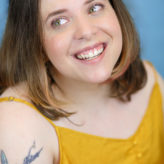The other night, I almost walked past a container of chocolate chip cookies on my kitchen counter without taking one. I knew exactly what they’d taste like. They were soft-chew. Like Entenmann’s, but from a supermarket trying to be better. They wouldn’t be better and they are not worth the calories. I thought all of this as I walked past my counter, and then doubled back, picking up two and stuffing them in my mouth with a mix of shame and pride.
I’m well-past my high school years, but every time I deny myself food I flash back to one day at lunch in the cafeteria, when I stared at a taco with fear of the calories and fat it would add to my body, rolled over to the garbage can in my wheelchair, and threw it out with tears in my eyes.
I was never diagnosed with an eating disorder, so I call that period of my life my disordered eating struggle. While I am proud of what I’ve overcome, as an ambulatory wheelchair user with Cerebral Palsy (CP), the lack of recognition my behavior received from both my family and the medical community left a scar that shows itself late at night when I walk past cookies on the counter during quarantine. I’m trying to lose weight, but I fear thoughts of restriction.
I’d never heard anyone talk about the relationship between visible disability and disordered eating behavior until I read Keah Brown’s collection of essays, The Pretty One early in 2020. There are no studies I can cite, no “experts” to talk to who could help her and I make sense of our past or present struggles with eating as it relates to CP. All I could do was share my gratitude with Brown for writing about her struggle, and tell her about mine in hopes our conversation would push me through my current negative thoughts about my body.
As a Black, queer, disabled woman, Brown gets a stronger negative message about herself from the media than I do as a white-passing part Latinx woman. “There are so many communities in which [I can] identify, but I’m not the one people see,” she said, confirming that she feels this way about her eating disorder (a term she uses) experience, too.
My unhealthy eating patterns began because I needed control — of my grades, of my body, of the stress I was feeling at 16. I felt like I couldn’t control any of those things, but I could control what I ate and how much I exercised. Brown felt similarly.
“I don’t have control over whether or not I do great in a class I’m struggling with despite how much I’m studying, or I don’t have control over not getting free drinks at the bar because I’m not as ‘pretty’ as all my friends,” Brown reflected on past thoughts. “I don’t have control over the fact that I’m sad all the time. But food was the thing that I felt like I had control over.”
As for how these struggles connect to our disabilities, we differ slightly. I was hoping that if I could just have an eating disorder, my disability would disappear. Brown — who is a full-time walker whose CP affects one side of her body — was hoping to distract people from her disability with beauty, or, in her own words, “It was just like, ‘I just want to distract people, because if I’m beautiful and skinny they won’t care about my disability.’”
Brown was never diagnosed with an eating disorder either, though she was sent to a nutritionist at the request of a counselor, and identifies as having had one because, “…when we follow everything by the medical model, we leave so many people out.”
At the risk of sounding cavalier, the worst part of my disordered eating story ended when I got hungry, perhaps culminating one night when I woke up on my kitchen floor after passing out from hunger just seconds before my parents got home from the airport. Or in the late-night screaming match I had with my mom after a trip to the diner, when she told me she knew I was binging and purging.
Brown and I had no choice but to overcome our unhealthy eating behaviors with little help from others. Disabled body image issues are hardly ever acknowledged because that would require acknowledging disabled bodies. “[Disabled people are] this thing that [society is] so desperate to often sweep under the rug,” Brown said. “But that’s why I’m so adamant about being like, ‘No I’m here and I’m not going anywhere and you can’t make me.’”
She gained notoriety when the hashtag she created, #DisabledAndCute, went viral, and told me that it wouldn’t exist if not for her eating disorder struggle. Physically harming herself was the way Brown got revenge on her body for being different. Without that time in her life, #DisabledAndCute wouldn’t exist. “They’re very much tied to each other in that….the further I get in my own self-love journey, I just look back at the person that I was in that time that I was[restricting food] every day….and I’m like, ‘We’ve come so far and I’m so proud of us.’”
Our struggles with body image aren’t over because our disordered eating is dormant. Brown gets through a bad day by putting on red lipstick and reminding herself of three physical traits she likes about herself and one internal trait. I’m trying to look inward and practice meditation. On my hardest days, I’m thankful for Brown’s courage to write, because without her words I’d still think no one could relate to my struggles with food as a disabled woman. I’m so proud of us.



